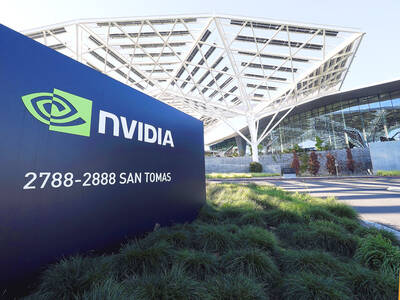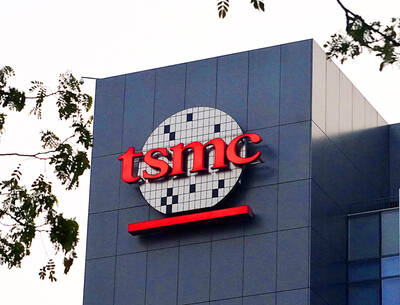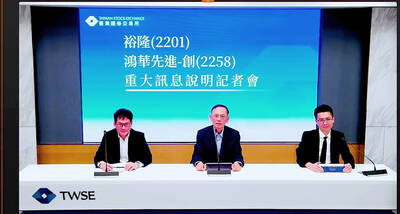Two US setbacks this week in the race to the moon with China illustrate the risks of NASA’s plans to bet on a new strategy of relying heavily on private companies.
Fresh delays in the US space agency’s Artemis moon program and a propulsion issue that doomed US company Astrobotic’s recent robot moon lander illustrate the difficulties faced by the only country to have set foot on the moon, as it tightens budgets while carrying on its cosmic legacy.
The US is planning to put astronauts back on the moon in late 2026 — delayed this week from next year — while China is targeting 2030 for its crewed landings. Before humans arrive, each space power plans to first send several smaller robotic missions to examine the moon’s surface. China’s government-backed program has scored a string of firsts.

Photo: AP
Astrobotic’s lander carried seven NASA instruments that were meant to inspect the lunar surface. Although the lander cannot make it to the surface intact, three other private moon missions sponsored by NASA, including a second Astrobotic attempt, are planned for this year.
NASA is leaning heavily on other companies such as Elon Musk’s SpaceX — which it will pay for the use of its Starship HLS lunar landing spacecraft — to slash the cost of its moon missions. The last crewed moon trips were the US Apollo missions more than half a century ago, when NASA owned all the spacecraft involved.
“I think that China has a very aggressive plan,” NASA chief Bill Nelson said on Tuesday after announcing the Artemis delay. “I think they would like to land before us, because that might give them some PR coup. But the fact is, I don’t think they will.”
US startups must develop space expertise and culture that took well-funded governments decades to develop. India is also taking that approach — leaning heavily on private companies in its space exploration efforts.
“Ten thousand things have to go right” in a debut moonshot such as Astrobotic’s, said Carnegie Mellon professor Red Whittaker, who led development of a tiny four-wheeled moon rover that was aboard Peregrine. “It’s very, very common in the course of a mission that glitches are encountered.”
Astrobotic said its executives were unavailable for interviews this week, but its Peregrine mission director, Sharad Bhaskaran, told reporters last year the company’s challenges were steep.
“We have to be a commercial company. We’re trying to be competitive in this new era of commercial spaceflight. When you look at the budgets, we have to be more creative and more efficient and do things differently,” Bhaskaran said.
China’s next step in its lunar exploration program involves an automated mission this year to retrieve samples on the moon’s far side — which would be the next in a series of firsts.
In December 2013, China’s uncrewed Chang’e-3 made the world’s first lunar soft landing since 1976. In January 2019, the also uncrewed Chang’e-4 landed on the far side of the moon, also a first.
India and firms from Israel and Japan have failed in their moon attempts in recent years.
India, which succeeded last year on its second try with its Chandrayaan-3 lander and became the first nation to touch down on the moon’s south pole, sees Astrobotic’s failure as a lesson.
“This is a much-needed learning curve for private entities similar to what the government agencies of the US, Russia and India had through their first landing attempts,” said Pawan Kumar Chandana, co-founder of Skyroot Aerospace, which launched India’s first private rocket in 2022.
“It inspires our startups to take up missions of this scale in the future,” he said.
US moon lander startup Intuitive Machines is next up in the private sector’s bid to reach the moon, and has spent about US$100 million on the mission, the company’s CEO Steve Altemus told reporters last year.
“We had to build an entire lunar program, not just a lander. So it was a little more expensive,” he said.

CHIP RACE: Three years of overbroad export controls drove foreign competitors to pursue their own AI chips, and ‘cost US taxpayers billions of dollars,’ Nvidia said China has figured out the US strategy for allowing it to buy Nvidia Corp’s H200s and is rejecting the artificial intelligence (AI) chip in favor of domestically developed semiconductors, White House AI adviser David Sacks said, citing news reports. US President Donald Trump on Monday said that he would allow shipments of Nvidia’s H200 chips to China, part of an administration effort backed by Sacks to challenge Chinese tech champions such as Huawei Technologies Co (華為) by bringing US competition to their home market. On Friday, Sacks signaled that he was uncertain about whether that approach would work. “They’re rejecting our chips,” Sacks

Taiwan’s long-term economic competitiveness will hinge not only on national champions like Taiwan Semiconductor Manufacturing Co. (TSMC, 台積電) but also on the widespread adoption of artificial intelligence (AI) and other emerging technologies, a US-based scholar has said. At a lecture in Taipei on Tuesday, Jeffrey Ding, assistant professor of political science at the George Washington University and author of "Technology and the Rise of Great Powers," argued that historical experience shows that general-purpose technologies (GPTs) — such as electricity, computers and now AI — shape long-term economic advantages through their diffusion across the broader economy. "What really matters is not who pioneers

BUBBLE? Only a handful of companies are seeing rapid revenue growth and higher valuations, and it is not enough to call the AI trend a transformation, an analyst said Artificial intelligence (AI) is entering a more challenging phase next year as companies move beyond experimentation and begin demanding clear financial returns from a technology that has delivered big gains to only a small group of early adopters, PricewaterhouseCoopers (PwC) Taiwan said yesterday. Most organizations have been able to justify AI investments through cost recovery or modest efficiency gains, but few have achieved meaningful revenue growth or long-term competitive advantage, the consultancy said in its 2026 AI Business Predictions report. This growing performance gap is forcing executives to reconsider how AI is deployed across their organizations, it said. “Many companies

TAIWAN VALUE CHAIN: Foxtron is to fully own Luxgen following the transaction and it plans to launch a new electric model, the Foxtron Bria, in Taiwan next year Yulon Motor Co (裕隆汽車) yesterday said that its board of directors approved the disposal of its electric vehicle (EV) unit, Luxgen Motor Co (納智捷汽車), to Foxtron Vehicle Technologies Co (鴻華先進) for NT$787.6 million (US$24.98 million). Foxtron, a half-half joint venture between Yulon affiliate Hua-Chuang Automobile Information Technical Center Co (華創車電) and Hon Hai Precision Industry Co (鴻海精密), expects to wrap up the deal in the first quarter of next year. Foxtron would fully own Luxgen following the transaction, including five car distributing companies, outlets and all employees. The deal is subject to the approval of the Fair Trade Commission, Foxtron said. “Foxtron will be